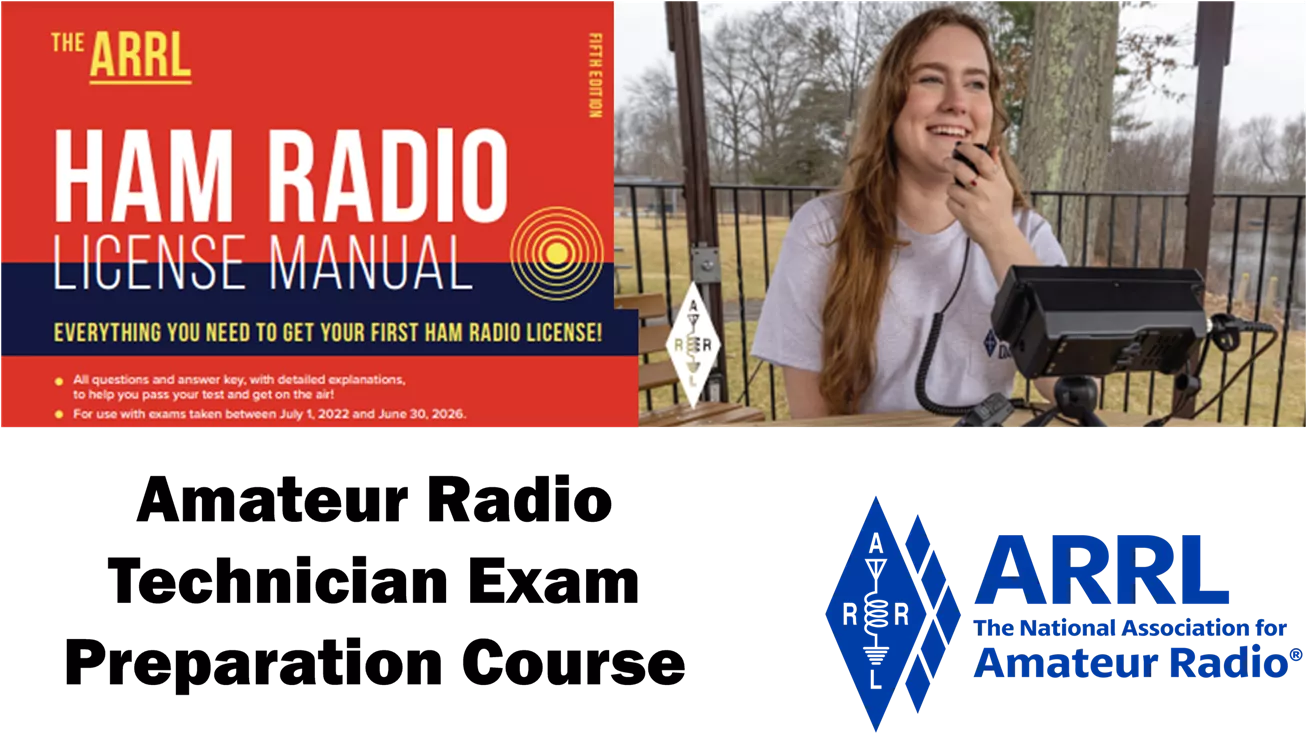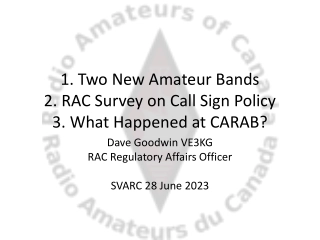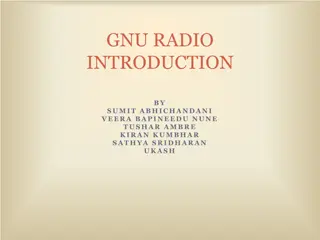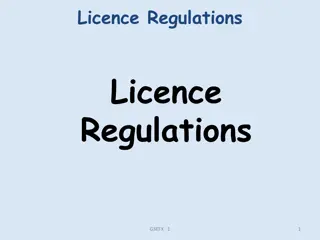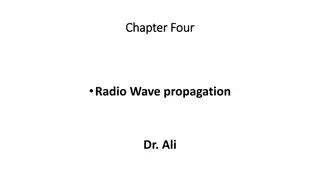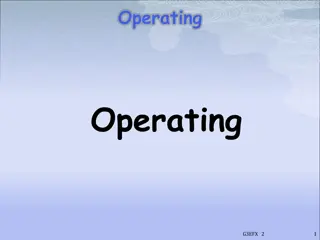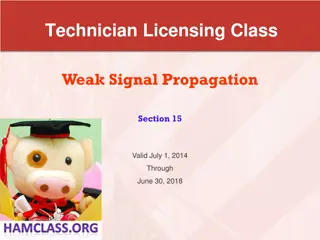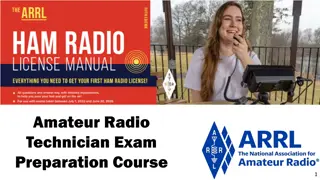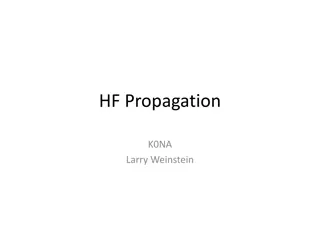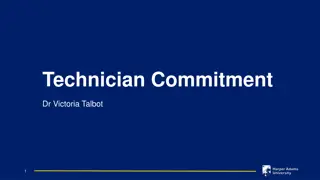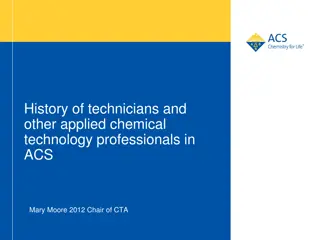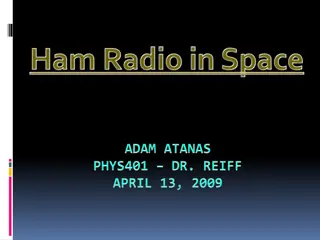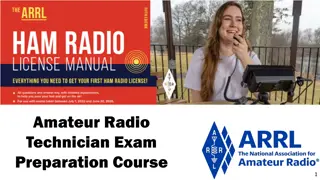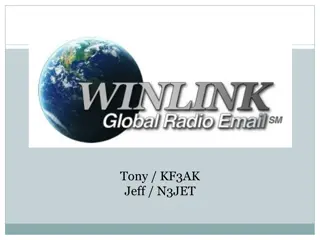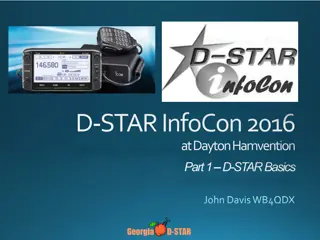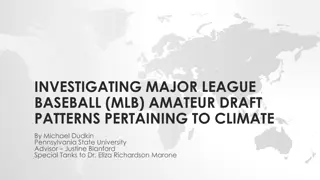Amateur Radio Technician Exam Preparation Overview
Dive into the world of Amateur Radio Technician Exam Preparation with a focus on licensing regulations, types and classes of licenses, sample licenses, exam procedures, and more. Learn about the FCC's rules for the amateur radio service, licensing terms, the different classes of licenses available, and how to successfully pass the examinations administered by volunteer examiners. Explore the privileges and responsibilities that come with holding an amateur radio license and gain insights into the exciting realm of ham radio operations.
Download Presentation

Please find below an Image/Link to download the presentation.
The content on the website is provided AS IS for your information and personal use only. It may not be sold, licensed, or shared on other websites without obtaining consent from the author.If you encounter any issues during the download, it is possible that the publisher has removed the file from their server.
You are allowed to download the files provided on this website for personal or commercial use, subject to the condition that they are used lawfully. All files are the property of their respective owners.
The content on the website is provided AS IS for your information and personal use only. It may not be sold, licensed, or shared on other websites without obtaining consent from the author.
E N D
Presentation Transcript
Amateur Radio Technician Exam Preparation Course 1
Amateur Radio Technician Exam Prep Course Module 7 Licensing Regulations 7.1 Licensing Terms 7.2 Bands and Privileges 7.3 International Rules 7.4 Call Signs 2 2
Licensing Terms The Federal Communications Commission or FCC makes and enforces the rules for the Amateur Radio service in the United States Detailed list of rules & regulations at http://www.arrl.org/part-97-amateur-radio Amateur radio is non-commercial hams aren t allowed to be paid for their services (with a few exceptions) voluntary Hams use various events to train to operate radio equipment in useful ways and to keep their emergency response skills sharp, such as Competitive operating events, chasing awards, and station-building 3 3
Types and Classes of Licenses An Amateur Radio license consists of two parts an operator license and a station license Operator license gives you permission to operate an amateur station Station license authorizes you to have an amateur station Each person can have only ONE such license There are three classes of Amateur Radio licenses being granted today: Technician, General, and Amateur Extra Each carries a different set of frequency and operating privileges Clubs can also be license holders Clubs must have at least FOURmembers to be organized see rule 97.5 (b) 4 4
Sample license Figure 7.1 An FCC Amateur Radio license is both an operator and a station license. The printed license shown here has two sections: one for posting in your station and one to carry with you. For information on obtaining a copy of your license, see www.arrl.org/obtain-license-copy. 5
Examinations Amateur volunteers run their own exam sessions Volunteer Examiner Coordinators (VEC): An organization or group that administers exams Volunteer Examiner (VE): An individual amateur radio operator that actually gives the exam (reports to a VEC) General class or higher (however, Technicians can assist) Exams are referred to by elements Element 2 Technician (35 questions, 26 required to pass) Element 3 General (35 questions, 26 required to pass) Element 4 Extra (50 questions, 37 required to pass) Test forms are filed with the FCC by the VEC administering the exam Once your information shows up in the FCC ULS database, you are fully authorized to operate 6 6
Term of License and Renewal Amateur licenses are good for a 10-year term, renewable without reexamination If your license expires, you are supposed to stop transmitting because your license is no longer valid You have a two-year grace period to apply for a new license To find an exam location https://www.arrl.org/find-an-amateur-radio-license-exam-session Bring to the exam Two forms of ID (one a photo ID) FCC Registration Number (FRN) https://apps2.fcc.gov/fccUserReg/pages/createAccount.htm 7 7
Your Responsibilities The FCC requires you to provide and maintain a valid current mailing and email address in their database at all times Your license can be suspended or revoked and removed from the database You are obligated to make your station available for inspection upon request by an FCC representative Keep your original license available for inspection 9 9
Bands and Privileges There are hundreds of bands and dozens of different types of radio spectrum users The frequency privileges granted to the various services are called allocations Most common bands used by Technicians 6 meters (50 54 MHz) 2 meters (144 148 MHz) 70 cm (420 450 MHz) See Table 7.2, Table 7.3, and Figure 7.3 in your text Technician privileges at http://www.arrl.org/files/file/Tech%20Band%20Chart/US%20Amateur%20Radio%20 Technician%20Privileges.pdf 10 10
Emission Privileges Emission is the formal name for any radio signal from a transmitter An emission privilege is permission to communicate using a particular mode (phone, CW, data, image, etc.) Beacons are found on 10 meters between 28.2 and 28.3 MHz and in the lower segments of the VHF, UHF, and microwave bands 13 13
Power Limits Output power from a transmitter or amplifier is defined in terms of peak envelope power (PEP) Amateurs are allowed the full legal limit of 1500 watts PEP output (some exceptions) Below 30 MHz, Novice and Technician licensees are limited to 200 watts PEP on HF bands 14 14
Primary and Secondary Allocations Many amateur bands are exclusively allocated to hams Occasionally two services receive shared allocations (even ham bands) One group is generally given priority called primary allocation Lower priority is called secondary allocation The primary service is protected from harmful interference by signals from secondary services For example, amateurs have a secondary allocation in the 70 cm band and must avoid interfering with radiolocation stations that have primary status Part 97.303 lists all of the frequency-sharing requirements for US hams (see www.arrl.org) 15 15
Repeater Coordination (includes Auxiliary Stations) Hams have developed a system of regional frequency coordination to ensure that repeaters use amateur bands wisely and avoid interference to the greatest degree possible (not FCC controlled) Repeaters input and output frequency pairs are fixed and have a common offset in each region A committee of volunteers known as a frequency coordinator recommends transmit and receive frequencies Frequency coordinator representatives are selected by local or regional amateurs whose stations are eligible to be repeater stations Uncoordinated repeaters are strongly discouraged because they often cause interference 16 16
Which agency regulates and enforces the rules for the Amateur Radio Service in the United States? A. FEMA B. Homeland Security C. The FCC D. All these choices are correct T1A02 C 97.1 7-1 18 18
Which of the following is part of the Basis and Purpose of the Amateur Radio Service? A. Providing personal radio communications for as many citizens as possible B. Providing communications for international non-profit organizations C. Advancing skills in the technical and communication phases of the radio art D. All these choices are correct T1A01 C 97.1 7-2 19 19
How many operator/primary station license grants may be held by any one person? A. One B. No more than two C. One for each band on which the person plans to operate D. One for each permanent station location from which the person plans to operate T1A04 A 97.5(b)(1) 7-3 20 20
For which license classes are new licenses currently available from the FCC? A. Novice, Technician, General, Amateur Extra B. Technician, Technician Plus, General, Amateur Extra C. Novice, Technician Plus, General, Advanced D. Technician, General, Amateur Extra T1C01 D 97.9(a), 97.17(a) 7-3 21 21
Which of the following is a requirement for the issuance of a club station license grant? A. The trustee must have an Amateur Extra Class operator license grant B. The club must have at least four members C. The club must be registered with the American Radio Relay League D. All these choices are correct T1F11 B 97.5(b)(2) 7-3 22 22
What proves that the FCC has issued an operator/primary license grant? A. A printed copy of the certificate of successful completion of examination B. An email notification from the NCVEC granting the license C. The license appears in the FCC ULS database D. All these choices are correct T1A05 C 97.7 7-5 23 23
How soon after passing the examination for your first amateur radio license may you transmit on the amateur radio bands? A. Immediately on receiving your Certificate of Successful Completion of Examination (CSCE) B. As soon as your operator/station license grant appears on the ARRL website C. As soon as your operator/station license grant appears in the FCC s license database D. As soon as you receive your license in the mail from the FCC T1C10 C 97.5a 7-5 24 24
What is the normal term for an FCC-issued amateur radio license? A. Five years B. Life C. Ten years D. Eight years T1C08 C 97.25 7-5 25 25
What is the grace period for renewal if an amateur license expires? A. Two years B. Three years C. Five years D. Ten years T1C09 A 97.21(a)(b) 7-5 26 26
If your license has expired and is still within the allowable grace period, may you continue to transmit on the amateur radio bands? A. Yes, for up to two years B. Yes, as soon as you apply for renewal C. Yes, for up to one year D. No, you must wait until the license has been renewed T1C11 D 97.21(b) 7-5 27 27
What may happen if the FCC is unable to reach you by email? A. Fine and suspension of operator license B. Revocation of the station license or suspension of the operator license C. Revocation of access to the license record in the FCC system D. Nothing; there is no such requirement T1C04 B 97.23 7-8 28 28
Which of the following can result in revocation of the station license or suspension of the operator license? A. Failure to inform the FCC of any changes in the amateur station following performance of an RF safety environmental evaluation B. Failure to provide and maintain a correct email address with the FCC C. Failure to obtain FCC type acceptance prior to using a home-built transmitter D. Failure to have a copy of your license available at your station T1C07 B 97.23 7-8 29 29
Which of the following frequency ranges are available for phone operation by Technician licensees? A. 28.050 MHz to 28.150 MHz B. 28.100 MHz to 28.300 MHz C. 28.300 MHz to 28.500 MHz D. 28.500 MHz to 28.600 MHz T1B01 C 97.301 (e) 7-9 30 30
Which frequency is in the 6 meter amateur band? A. 49.00 MHz B. 52.525 MHz C. 28.50 MHz D. 222.15 MHz T1B03 B 97.301(a) 7-9 31 31
Which amateur band includes 146.52 MHz? A. 6 meters B. 20 meters C. 70 centimeters D. 2 meters T1B04 D 97.301(a) 7-9 32 32
On which HF bands does a Technician class operator have phone privileges? A. None B. 10 meter band only C. 80 meter, 40 meter, 15 meter, and 10 meter bands D. 30 meter band only T1B06 B 97.301(e), 97.305 7-9 33 33
How may amateurs use the 219 to 220 MHz segment of 1.25 meter band? A. Spread spectrum only B. Fast-scan television only C. Emergency traffic only D. Fixed digital message forwarding systems only T1B05 D 97.305(c) 7-11 34 34
Which of the following VHF/UHF band segments are limited to CW only? A. 50.0 MHz to 50.1 MHz and 144.0 MHz to 144.1 MHz B. 219 MHz to 220 MHz and 420.0 MHz to 420.1 MHz C. 902.0 MHz to 902.1 MHz D. All these choices are correct T1B07 A 97.305(a), (c) 7-11 35 35
What is the maximum peak envelope power output for Technician class operators in their HF band segments? A. 200 watts B. 100 watts C. 50 watts D. 10 watts T1B11 A 97.313 7-12 36 36
Except for some specific restrictions, what is the maximum peak envelope power output for Technician class operators using frequencies above 30 MHz? A. 50 watts B. 100 watts C. 500 watts D. 1500 watts T1B12 D 97.313(b) 7-12 37 37
How are US amateurs restricted in segments of bands where the Amateur Radio Service is secondary? A. U.S. amateurs may find non-amateur stations in those segments, and must avoid interfering with them B. U.S. amateurs must give foreign amateur stations priority in those segments C. International communications are not permitted in those segments D. Digital transmissions are not permitted in those segments T1B08 A 97.303 7-13 38 38
Which of the following entities recommends transmit/receive channels and other parameters for auxiliary and repeater stations? A. Frequency Spectrum Manager appointed by the FCC B. Volunteer Frequency Coordinator recognized by local amateurs C. FCC Regional Field Office D. International Telecommunication Union T1A08 B 97.3(a)(22) 7-13 39 39
Who selects a Frequency Coordinator? A. The FCC Office of Spectrum Management and Coordination Policy B. The local chapter of the Office of National Council of Independent Frequency Coordinators C. Amateur operators in a local or regional area whose stations are eligible to be repeater or auxiliary stations D. FCC Regional Field Office T1A09 C 97.3(a)(22) 7-13 40 40
International Rules Every country has its equivalent agency to the FCC The International Telecommunication Union (ITU) coordinates allocations across international borders The ITU divides the world into the three regions US is region 2 (except for some territories in the Pacific region 3) Unless specifically prohibited by the government of either country, any ham can talk to any other ham International communications must be limited to the purposes of the amateur service or remarks of a personal nature The FCC can prohibit contacts between US citizens and those of specific other countries by notifying the ITU of its objections (uncommon!) 41 41
International Operating The foreign country must permit amateur operation (some don t) You must have permission when you are inside a country s national boundaries (and territorial waters) You are required to operate according to their rules You may also operate from any vessel or craft that is documented or registered in the United States If the vessel is in territorial waters, regulations of the host country and those of the vessel s registry both apply 42 42
Call Signs Amateur call signs have a prefix and suffix Prefix: One or two letters and one numeral Suffix: One to three letters Technician class license holders may choose their own vanity call sign (from Groups C or D) US Amateur Call Sign Formats 43 43
US Call Districts You are assigned the numeral part of your call by the FCC, based upon where you live. If you move, this number stays with you. HOWEVER, you may request (and obtain) a vanity call outside your district! 44
What types of international communications are an FCC- licensed amateur radio station permitted to make? A. Communications incidental to the purposes of the Amateur Radio Service and remarks of a personal character B. Communications incidental to conducting business or remarks of a personal nature C. Only communications incidental to contest exchanges; all other communications are prohibited D. Any communications that would be permitted by an international broadcast station T1C03 A 97.117 7-15 46 46
With which countries are FCC-licensed amateur radio stations prohibited from exchanging communications? A. Any country whose administration has notified the International Telecommunication Union (ITU) that it objects to such communications B. Any country whose administration has notified the American Radio Relay League (ARRL) that it objects to such communications C. Any country banned from such communications by the International Amateur Radio Union (IARU) D. Any country banned from making such communications by the American Radio Relay League (ARRL) T1D01 A 97.111(a)(1) 7-15 47 47
From which of the following locations may an FCC-licensed amateur station transmit? A. From within any country that belongs to the International Telecommunication Union B. From within any country that is a member of the United Nations C. From anywhere within International Telecommunication Union (ITU) Regions 2 and 3 D. From any vessel or craft located in international waters and documented or registered in the United States T1C06 D 97.5(a)(2) 7-15 48 48
Who may select a desired call sign under the vanity call sign rules? A. Only a licensed amateur with a General or Amateur Extra Class license B. Only a licensed amateur with an Amateur Extra Class license C. Only a licensed amateur who has been licensed continuously for more than 10 years D. Any licensed amateur T1C02 D 97.19 7-17 49 49
Which of the following is a valid Technician class call sign format? A. KF1XXX B. KA1X C. W1XX D. All these choices are correct T1C05 A 7-17 50 50



